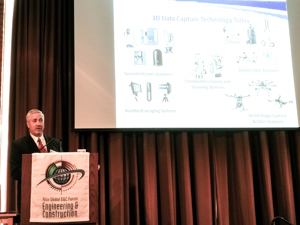Rice Global E&C Forum: 3D laser scanning critical to reducing errors during design-build
HOUSTON—Matthew Craig, Senior Advisor for Becht Engineering's Technology Services division, spoke today at the Rice Global Engineering & Construction Forum, hosted by Rice University.
Becht Dimensional Technology Services was established in 2009 and provides 3D laser scanning, dimensional control and inspection, and digital asset management services. In his talk, Mr. Craig discussed how 3D data capture (laser scanning) has changed how EPC organizations execute capital projects.
Laser scanning evolution. Laser scanning technology has been in use for decades, but its evolution has been rapid. Point cloud overlays were enhanced with 3D computer-assisted design (CAD) programs, which have given way to terrestrial laser scanners, handheld imaging systems, combination survey and scanning systems, mobile LIDAR scanners, and aerial image capture and LIDAR scanners.
Data then became stored in the cloud and linked with other smart applications, making it instantly available to engineers around the world. "This helps facilitate the overall digital transformation lifecycle of the plant," Mr. Craig noted. "It's a very useful engineering tool."
Cost savings with 3D laser scanning. The cost savings with 3D laser scanning comes from first identifying issues at each plant. "You can't find a root cause of engineering issues unless there's something to measure against," said Mr. Craig. "Most of the issues in the field—about 80%—come from inconsistencies and uncertainties in measurement." Measurement accuracy tolerances in the field are typically within +/– 1 in. (25 mm).
This is where laser scanning comes in. Different measurement technologies are required to achieve specific accuracy of results. Visualization via 3D laser scanning helps cut out re-work, which is estimated to cost $15 B/yr and comprise 2%–20% of a project's total contract.
The work processes enabled by the technology are repeatable and reliable. Laser scanning technology provides consistent, cost-effective, faster and safer visual measurement information to capture data in "as-is" condition, surpassing the efficiency and quality of traditional/manual measurement methods.
3D scanning critical to design-build processes. Documented benefits of using 3D laser scanning include a 90%–95% reduction in site visits, a total installed cost (TIC) reduction of 5%–7%, a 2% reduction in rework contingency, a reduction in engineering schedule of 10%–15%, a decrease in construction schedule of 5%–10%, and a reduction in design re-work of 1%–3%.
Mr. Craig expects 3D data capture to become smaller, faster and more accurate in the future. Cloud-based 3D applications will continue to increase, and flash LIDAR and robot-based 3D capture technologies will enter the market.
Real-time 3D data capture will also become a reality, making 3D laser scanning an increasingly critical part of the design-build and digital transformation initiatives.
The next Rice Global E&C Forum will take place Friday, January 10, on the topic of "Advance your career in downturns."







Comments